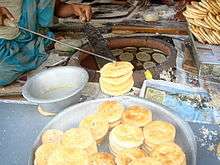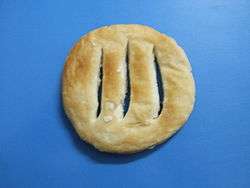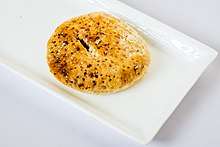Bakarkhani
Bakarkhani (Bengali: বাকরখানি, romanized: Bakorkhani) or baqarkhani, also known as bakar khani roti, is a thick, spiced flatbread that originated in modern-day Bangladesh during the Mughal period. With roots in Old Dhaka, the bread has developed several regional variants throughout the Indian subcontinent.[2] It is a very common breakfast snack in Old Dhaka, where it is also most popular in.[1] Outside of Dhaka, Bakarkhani is prepared on certain Muslim religious festivals and is now popular as a sweet bread across the subcontinent.[3]
 Bakarkhani being made in Dhaka, Bangladesh. They can be seen lining the walls of the tandoor oven. | |
| Alternative names | Shukha |
|---|---|
| Type | Bread |
| Course | Appetizer/Dessert |
| Place of origin | Bangladesh (Sylhet[1] and Old Dhaka) |
| Region or state | Indian subcontinent |
| Associated national cuisine | Bangladesh, India and Pakistan |
| Main ingredients | Dough, ghee, milk, sugar (optional) |
| Variations | Gao-joban, Shuki (shukha), Nimshuki, Kaicha-ruti, Mulam, Chinshuki, Kashmiri |
Bakarkhani is almost biscuit-like in texture, with a hard crust. The chief ingredients are flour, semolina, sugar, molasses soaked in saffron, poppy or nigella seeds, salt, and ghee (clarified butter).
History

Although most popularly eaten in Old Dhaka, where it is an authentic tradition, the makers of bakarkhani tend to have roots in Sylhet. Many rebellious Afghans migrated to the Sylhet region during the Baro-Bhuiyan period as it was seen as a safe-zone for them due to the strong insurgency of rebellious chieftains. The final Afghan ruler, Khwaja Usman, was defeated by the Mughals in 1612 and the remaining Afghans surrendered though continuing to live in Sylhet. The rebels which were captured by the Mughals were made to serve a type of bread associated with their Afghan culture (which would later be known as bakarkhani). As Dhaka was the capital of Mughal Bengal, people from all over Bengal, including Sylhet, would migrate there seeking employment opportunities. The elites of Dhaka had good relations with the upper-class families of Sylhet, and transport between these two regions were common. Many Sylhetis who came to Dhaka started making this bread which they supposedly learnt from the Afghans which lived in Sylhet.[4][1] Many of Dhaka's bakarkhani sellers even today originate from the Sylhet Division.[5]
A legend attributes the bread's name to Agha Baker Khan, an adopted son of the Nawab of Bengal, Murshid Quli Khan.[6] According to the legend, Agha Baker Khan, a general based in Chittagong under Nawab Siraj ud-Daulah of Bengal, falls in love with a dancer called Khani Begum from Arambagh, who was also eyed by Zaynul Khan, the city's kotwal and the son of a wazir. Zaynul attempts to attack Khani for rejecting him, and Baker intervenes, defeating Zaynul in a swordfight. Zaynul 's two companions go and lie to his father, the wazir, telling him that Baker has killed Zaynul. Out of fury, the wazir orders them to put Baker inside a cage with a tiger. Baker kills the tiger and at the same time, the claim of Zaynul's death is found to be false. The wazir, Jahandar Khan, and his son Zaynul then kidnap Khani and set off for South Bengal. The battle continues there as Baker arrives to rescue Khani. In another brawl of talwars, Jahandar accidentally kills Zaynul, after Zaynul inadvertently murders Khani. Khani is later buried in Bakla-Chandradwip (Patuakhali-Barisal). Baker Khan builds a tomb over her grave and Bakla-Chandradwip would be renamed Bakerganj after him.[2] Baker was already familiar with this area as he was a jagirdar in Barisal's Salimabad and Umedpur parganas.[7] The tragic love story of Baker Khan and Khani Begum inspired the bakers to name his favourite bread Bakerkhani.[8][9] Dhaka's first bakarkhani shop opened in close proximity to Lalbagh Fort.
The Bengal Subah, specifically Mughal Dhaka, was a hub for merchants from all parts of the subcontinent and even as far as the Middle East and Armenia. Through trade and travel, the bakerkhani became popular outside of Bengal in places such as Kashmir, Bihar, Lucknow and Hyderabad.[10]
Preparation

Bakerkhani is made by kneading together flour, ghee, in some cases cardamom, sugar and salt with water. The dough is then flattened. The bread is made by stretching a sheet of dough repeatedly and interleaving with ghee, molasses, saffron water, poppy or nigella seeds before baking on a tandoor or tawa girdle.
Variations

It is also known as shukha (meaning 'dry') naan or shukha roti due to its dry texture.[6] Hakim Habibur Rahman, author of Dhaka Panchas Baras Pahle, lists three variations of bakarkhani; Gao-joban, shuki (shukha) and nimshuki. There are also other variations such as kaicha-ruti, mulam and chinshuki.[2]
In literature
Bakarkhani is mentioned in a Bengali poem by Pratul Mukhopadhyay:
Aalu becho, chhola becho, becho bakorkhani
Becho na becho na bondhu tomar chokher moṇi,
Jhinge becho pãch shikete hazar takay shona
Haater kolom jonom dukhi take becho na.[4]
See also
- List of Indian breads
- List of Pakistani breads
| Wikimedia Commons has media related to Bakarkhani. |
References
- "বাকরখানি: অমর প্রেমের কাহিনী". The Daily Janakatha (in Bengali). 21 January 2017.
- Hossain, Muhammad Faruque (2012). "Bakorkhani". In Islam, Sirajul; Miah, Sajahan; Khanam, Mahfuza; Ahmed, Sabbir (eds.). Banglapedia: the National Encyclopedia of Bangladesh (Online ed.). Dhaka, Bangladesh: Banglapedia Trust, Asiatic Society of Bangladesh. ISBN 984-32-0576-6. OCLC 52727562. Retrieved 30 July 2020.
- Shinwari, Sher Alam. "Local pizza, Bakarkhani bread gaining popularity". Dawn. Pakistan. Retrieved 24 February 2020.
- "পুরান ঢাকাবাসীর বাকরখানি না হলেই নয়" (in Bengali). DeshReview. 19 July 2017. Retrieved 4 December 2017.
- Muhammad Abu Talib (28 February 2015). "ঐতিহ্যের বাকরখানি যাচ্ছে বিদেশে". The Daily Ittefaq (in Bengali).
- Muntasir Mamun (July 2006). Dhaka Smriti-Bismritir Nogori (Updated Version). Dhaka: Anannya. p. 172. ISBN 984-412-104-3.
- Nazir Hussain (April 1995). Kingbodontir Dhaka (Edition 3). Dhaka: 3 Star Cooperative Multipurpose Society Ltd. p. 293.
- "Bakarkhani: delight in every bite". Daily Sun. Retrieved 5 May 2018.
- Prothom Alo, Chhutir Dine, 4 February 2006
- Katti, Madhuri (14 March 2019). "Bakarkhani: An Ode To Lost Love". Live History India.
- Afreen, Saima (6 December 2014). "Bakarkhani, only a sweet memory now". The Times of India. Retrieved 24 February 2020.
- "Culture of Anantnag". District Anantnag J&K. Archived from the original on 19 June 2009.
- "Kashmir has special confectionary – Thaindian News". Thaindian.com. 13 March 2008. Retrieved 18 July 2013.